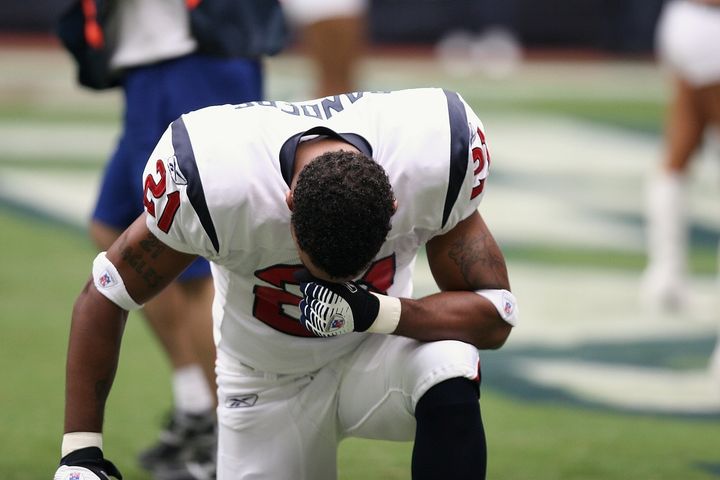
Professional football player takes a knee
It was not so long ago that Colin Kaepernik was seen as the “lone nut” in the NFL, the nation really, for demonstrating against racial injustice by taking a knee during the national anthem. Fast forward a year or so and we have totally different scenario on our hands. Kaepernik was not a lone nut after all; he was--and is-- the consummate example of a leader.
Small Actions at the Right Time
In his best-selling book Tipping Point, Malcolm Gladwell delves into the elements of leadership in great depth, at least in terms of setting trends. His emphasis on chain-influencers and "connectors" is particularly notable in the Colin Kaepernik saga. Connectors, Gladwell writes, are those people “who link us up with the world, who bridge Omaha and Sharon, who introduce us to our social circles – these people on whom we rely on more heavily than we realize – are Connectors... with a very special gift of bringing people together.”
Paul Loeb, author of Soul of a Citizen: Living with Conviction in Challenging Times, considered by many a handbook for social activism, examines how ordinary people can make courage contagious in the face of fear and hatred. While the acts of a famous NFL player could hardly be considered ordinary, his methods emulated by a few brave followers, say a handful of high school students, are precisely what give a movement its momentum.
The key message from Gladwell and Loeb is that small actions at the right time can have a profound impact on society. Yet, Gladwell notes that if the context is not right, nothing will happen --the tipping point will not take place. But if the right person, at the right time takes action, these connectors have a way of changing not just markets, but the world. It takes time, a little bit of luck, and above all it takes a leader with courage and conviction. "The success of any kind of social epidemic,” Gladwell writes “is heavily dependent on the involvement of people with a particular and rare set of social gifts." Perhaps unwittingly, Colin Kaepernik has that set of skills.
Whether or not you agree with the #takeaknee movement, Kaepernik is a prime example of a chain influencer, and like the Lone Nut video, an entire hillside is dancing with him today. But Kaepernik was dancing alone for a long time. He was ridiculed, ostracized, blasted by the media and ownership. He lost his job. Yet, he kept dancing, if not on the field then through his actions and words--or through his silence. He never stopped dancing to bring light to persistent racial injustice in America, even if it cost him future employment, which it did.
The incidents in Charlottesville, Virginia, followed by continued unrest across the country and preceded by a Presidential campaign filled with racial overtones suddenly brought Kaepernik’s actions into focus. To many, his taking a knee was no longer about a single “selfish” player, as he was repeatedly portrayed; nor was this about an athlete’s personal views. Suddenly, as others joined in, this was about solidarity, change, and collective action. While the motives for each player may be different, this is now a movement, foreshadowed by the acts of a single connector.
Athletes as Chain Influencers
Perhaps we should have all seen this coming. Then again, if that were the case the nation—or at least the NFL— would have been locking arms and taking knees a long time ago. But we didn’t, they didn’t, because we are not all brave leaders. And therein lies the importance of the current movement transferring to the playing fields and courts of America. You see, nowhere is the measure of great leadership more pronounced than in professional sports.
Athletes, perhaps more than most, know great leaders. They themselves are often in charge of teams, massive fan bases, brands, enterprises, millions of twitter followers and so forth. And just like powerful political leaders, athletes have a platform from which to have their voice heard. Kaepernik’s actions here are particularly pronounced because they came from a position of privilege and prominence, where one has the most to lose and the least to gain from speaking up.
In the past, Lebron James, among others, faced criticism for not doing the same. It was not until the President of the United States called Kaepernik a “Son of a Bitch” that other athletes stepped up their activist game. James rebuked the president by calling him a “bum”, while Golden State’s Stephen Curry, usually a soft-spoken leader very much in the mold of Loeb’s examples, refused a trip to The White House and shamed the president with a concise message of “that’s just not what leaders do.”
One Step Knee at a Time
As social unrest continues to grip the nation, there nonetheless seems to be an acute, if subconscious, awareness for the laws of motion, that for every action there is an equal and positive reaction. Issac Newton taught us this centuries ago, but it seems that we are only know realizing that this applies to humanity as well. Therefore, even with negative developments, like overt racist acts, we are seeing an equally pronounced movement to the contrary. All we needed was inertia, initial movement--and in human form that means a leader.
Perhaps Kaepernik knew what Newton taught us long ago and what Gladwell reminded us more recently: We are all interconnected. A ripple in the water can cause huge waves, tsunamis even. It just takes a single pebble. Or maybe a nut. A lone nut.
